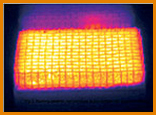Key Data
- Acronym: BIOFLAM

- Name: Development of domestic appliances based on cool flame vaporization and porous medium combustion
- Duration: 36 months (01.01.2001 | 31.12.2003)
- Number of Partners: 9
- Funding source: Fifth Framwork Programme (FP5 website)
- Project webpage: Bioflam page
- Status: closed
Abstract
The project intends to provide solutions to the problem ofenvironmental impact of combustion of liquid fuels for heating purposes (by reducing emissions, introducing usage of liquid renewable bio-fuels and improving efficiency), for the direct benefit of life and health quality, as well as the preservation of the environment and of the natural resources. It is partially funded by the European Commission within the EESD program.
The new domestic boiler will comprise three main parts: the vaporiser, the porous burner and the condensing boiler. It will accept a variety of domestic fuel mixtures comprising up to 20% of vegetable and/or recycled cooking oils. The control system, designed by CSEM, will have to include a few innovative elements in the field of flame detection and air/fuel ratio control over the whole range of operation (3 – 30 kW).
The development, prototyping and demonstration of new liquid fuel fired condensing boilers is aimed at, by developing new ceramic premixed liquid fuel burners based on the innovative cool flame vaporization process, the novel porous medium burner concept and the utilisation of high temperature ceramics, condensing boiler technology with condense water neutralization and innovative burner controls with a power modulation of at least 10:1.
Household heating with fuel oils is wide spread in Europe. Approximately 25% (corresponding to 30 million) of the households just in Western Europe use liquid fuels for heating purposes. A major reason for the use of fuel oil is the flexible fuel supply, which is independent of a permanent transport grid. Although the share of heating with fuel oil is slowly decreasing, it can be foreseen that it will not decrease to values less than 15% for the next 20 years. Combustion of fuel oils has disadvantages from the environmental point of view in comparison to natural gas and regenerative energy sources, like higher CO2 emissions per kWh, higher emissions of nitrogen oxides per kWh, acid compounds in the exhaust gases like SOx and higher noise emissions.
The BIOFLAM boiler addresses all these problems and will be able to burn not only fuel oil based on mineral oil but also vegetable oils, recycled cooking oils and mixtures (5% to 20% per volume in fuel oil) of those. Thus, CO2 emissions will be reduced by the partial use of renewable fuels. Existing oil burner technologies cannot operate with varying fuel types and especially with vegetable oils and recycled cooking oils. The BIOFLAM boiler will include neutralization of sulphuric acid and water condensation improving the overall efficiency by approx. 10% and thusreducing CO2 emissions. The BIOFLAM boiler will yield reduced NOx emissions by a factor of 2 in comparison to conventional oil boilers.
The BIOFLAM boiler will guarantee a basic heat power of about 3 kW and a maximum power output of 30 kW for rapid and efficient hot sanitary water production. High power modulation will offset the need of hot water hold-up (entailing a 20% energy saving with no penalty for users’ comfort) and allows easy integration with further renewable energy sources like solar energy systems. The challenges for the sensor and controls aspects are:
– The high modulation rate of 10:1 requires well-designed electronic controls, which are not available at present.
– The combustion is distributed in the porous matrix structure making it difficult to detect the flame.
– The air-fuel ratio control should react correctly to fuel load changes as well as to fuel quality changes.
– Low-cost sensors for air/fuel ratio control are not yet available however there are some new products, which are close to market introduction.
– The industrial cost of the overall control systems should not exceed 100 Euro.
Partners
- OMV AG (Austria) | Webpage
- EST RWTH-Aachen (Germany) | Webpage
- LSTM University of Erlangen (Germany) | Webpage
- Hovalwerk AG (Lichtenstein) | Webpage
- LASEF Instituto Superior Tecnico (Portugal) | Webpage
- National Technical University of Athens (Greece) | Webpage
- PTC SA* (Switzerland) | Webpage
- CSEM SA (Switzerland) | Webpage
*: The project was carried out by PTC SA, before being incorporated in Erbicol SA, and before being spinned off to EngiCer SA.














